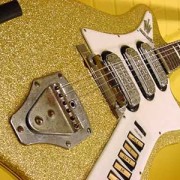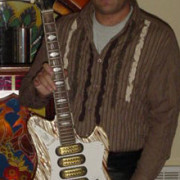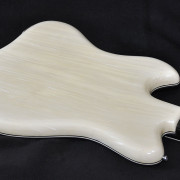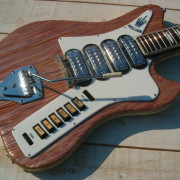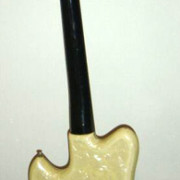Early Welson Solid-Bodied Guitars 1962 second half
by Jack Marchal
Two mint examples of classic Welson solid bodied guitars, with their new big chrome pickups. This version was available from mid-to-late 1962 to early 1963.
The simple floating bridge imitates the device Eko used two years earlier for its 400 series and discarded by late 1961. Both guitars shown here still have their original bridge, which is pretty rare.
Both are also showing on body back an accordion-style ‘cloudy’ mother-of-pearl celluloid. This finish is often found on guitars of this generation, and only of this one. The blue sparkle guitar sports a unique (or very rare) mottled pickguard.
A majority (roughly two thirds) of Welson celluloid covered solid bodies have four pickups. Unlike the Eko, Crucianelli, Bartolini-Gemelli guitars (and the Hagström Standard that inspired them all), the four pickups aren’t coupled two by two but are all are at regular spacings. Given their width and their plastic surrounds, they actually entirely fill the gap between bridge and fretboard, which gives those guitars their unique look.
Italiano
Due esempi immacolati di classiche solidbodies Welson con i nuovi grandi pickups cromati. Questa versione era distribuita nei ultimi mesi del 62 e l’inizio del 63.
Il semplice ponte flottante si ispira di quello che la Eko usava due anni prima per le sue 400 e abbandonò prima della fine del 62. Entrambe le Welson qui mostrate hanno conservato quello originale, caso assai poco frequente.
Tutte e due hanno inoltre sul retro un celluloide madreperlato ‘nuvoloso’, del tipo per fisarmoniche. Questa finitura si osserva spesso sulle chitarre della presente generazione, e solo su essa. Eccezionale (e forse unico) il battipenna marmorizzato della blù.
La maggioranza (circa i due terzi) delle Welson rifinite con celluloide hanno 4 pickups. Contrariamente alle Eko, Crucianelli, Bartolini-Gemelli (e alla Hagström Standard che le ha ispirate tutte), i 4 pickups non sono montati a coppie ma sono tutti ad intervalli regolari. Infatti, data la loro larghezza e la presenza di cornici di plastica, riempiono tutto lo spazio fra il ponte e la tastiera, dando a questi strumenti il loro aspetto unico.















